Nitrogen Removal from Landfill Leachate Using Biochar Derived from Wheat Straw
Abstract
1. Introduction
2. Materials and Methods
2.1. Material Collection and Preparation
2.2. Adsorbent (BC and AC) Property Determination
2.3. Landfill Leachate Collection
2.4. Adsorption Experiments
2.5. Adsorption Isotherm Model Study
3. Results and Discussion
3.1. Properties of the Commercial Activated Carbon and Straw Biochar
3.2. Adsorption Tests with Ammonium Chloride Solution for the AC and BC
3.3. Adsorption Test Results for Biochar on Landfill Leachate
3.4. Results for Adsorption Isotherms
3.5. Interpretation and Practical Considerations
3.6. Molecular Interactions and Adsorption Mechanisms
3.6.1. Adsorption on AC with Ammonium Chloride
3.6.2. Adsorption on Biochar (BC) with Landfill Leachate (LLCH)
3.7. Comparative Assessment with Previous Biochar Studies on Nitrogen Removal
4. Conclusions
Supplementary Materials
Author Contributions
Funding
Institutional Review Board Statement
Informed Consent Statement
Data Availability Statement
Conflicts of Interest
References
- Miladinov, G. Socioeconomic development and life expectancy relationship: Evidence from the EU accession candidate countries. Genus 2020, 76, 2. [Google Scholar] [CrossRef]
- Wu, Y.; Swain, R.E.; Jiang, N.; Qiao, M.; Wang, H.; Bai, J.; Zhou, X.; Sun, X.; Xu, J.; Xu, M. Design with nature and eco-city design. Ecosyst. Health Sustain. 2020, 6, 1781549. [Google Scholar] [CrossRef]
- Renou, S.; Givaudan, J.; Poulain, S.; Dirassouyan, F.; Moulin, P. Landfill leachate treatment: Review and opportunity. J. Hazard. Mater. 2008, 150, 468–493. [Google Scholar] [CrossRef]
- Hredoy, R.H.; Siddique, M.A.B.; Akbor, M.A.; Shaikh, M.A.A.; Rahman, M.M. Impacts of landfill leachate on the surrounding environment: A case study on Amin Bazar Landfill, Dhaka (Bangladesh). Soil Syst. 2022, 6, 90. [Google Scholar] [CrossRef]
- Wojnowska-Baryła, I.; Bernat, K.; Zaborowska, M. Plastic Waste Degradation in Landfill Conditions: The Problem with Microplastics, and Their Direct and Indirect Environmental Effects. Int. J. Environ. Res. Public Health 2022, 19, 13223. [Google Scholar] [CrossRef] [PubMed]
- Eurostat. 2023. Available online: https://ec.europa.eu/eurostat/databrowser/view/env_wasmun/default/table?lang=en (accessed on 21 March 2023).
- Lam, T.T. Use of Biochar and Zeolite for Landfill Leachate Treatment: Experimental Studies and Reuse Potential Assessment. Master’s Thesis, University of South Florida, Tampa, FL, USA, 2021. [Google Scholar]
- Beinabaj, S.M.H.; Heidarian, H.; Aleii, H.M.; Hosseinzadeh, A. Concentration of heavy metals in leachate, soil, and plants in Tehran’s landfill: Investigation of the effect of landfill age on the intensity of pollution. Heliyon 2023, 9, e13017. [Google Scholar] [CrossRef] [PubMed]
- Costa, A.M.; dos Santos Valentim, M.R.; de Azevedo, D.J.M.; Quintaes, B.R.; Daflon, S.D.A.; Campos, J.C. Evaluation of the Main Pollutants Present in Brazilian Landfill Leachates Using Ecotoxicity Assays. Process Saf. Environ. Prot. 2023, 173, 426–436. [Google Scholar] [CrossRef]
- Igwegbe, C.A.; Onukwuli, O.D.; Ighalo, J.O.; Menkiti, M.C. Bio-coagulation-flocculation (BCF) of municipal solid waste leachate using picralima nitida extract: RSM and ANN modelling. Curr. Res. Green Sustain. Chem. 2021, 4, 100078. [Google Scholar] [CrossRef]
- Kjeldsen, P.; Barlaz, M.A.; Rooker, A.P.; Baun, A.; Ledin, A.; Christensen, T.H. Present and long-term composition of MSW landfill leachate: A review. Crit. Rev. Environ. Sci. Technol. 2002, 32, 297–336. [Google Scholar] [CrossRef]
- Teng, C.; Zhou, K.; Peng, C.; Chen, W. Characterization and treatment of landfill leachate: A review. Water Res. 2021, 203, 117525. [Google Scholar] [CrossRef]
- Ambujan, A.; Thalla, A. An approach to quantify the contamination potential of hazardous waste landfill leachate using the leachate pollution index. Int. J. Environ. Sci. Technol. 2023, 21, 957–968. [Google Scholar] [CrossRef]
- Igwegbe, C.A.; Onukwuli, O.D.; Ighalo, J.O.; Umembamalu, C.J.; Adeniyi, A.G. Comparative analysis on the electrochemical reduction of colour, COD and turbidity from municipal solid waste leachate using aluminium, iron and hybrid electrodes. Sustain. Water Resour. Manag. 2021, 7, 39. [Google Scholar] [CrossRef]
- Kumar, V.; Sharma, N.; Umesh, M.; Chakraborty, P.; Kaur, K.; Duhan, L.; Sarojini, S.; Thazeem, B.; Pasrija, R.; Vangnai, A.S. Micropollutants characteristics, fate, and sustainable removal technologies for landfill leachate: A technical perspective. J. Water Process Eng. 2023, 53, 103649. [Google Scholar] [CrossRef]
- Zamparas, M.; Kyriakopoulos, G.L.; Kapsalis, V.C.; Drosos, M.; Kalavrouziotis, I.K. Application of novel composite materials as sediment capping agents: Column experiments and modelling. Desalination Water Treat. 2019, 170, 111–118. [Google Scholar] [CrossRef]
- Igwegbe, C.A.; Ovuoraye, P.E.; Białowiec, A.; Okpala, C.O.R.; Onukwuli, O.D.; Dehghani, M.H. Purification of aquaculture effluent using Picralima nitida seeds. Sci. Rep. 2022, 12, 21594. [Google Scholar] [CrossRef] [PubMed]
- Igwegbe, C.A.; Obi, C.C.; Ohale, P.E.; Ahmadi, S.; Onukwuli, O.D.; Nwabanne, J.T.; Białowiec, A. Modelling and optimisation of electrocoagulation/flocculation recovery of effluent from land-based aquaculture by artificial intelligence (AI) approaches. Environ. Sci. Pollut. Res. 2023, 30, 70897–70917. [Google Scholar] [CrossRef] [PubMed]
- Costa, A.M.; Alfaia, R.G.d.S.M.; Campos, J.C. Landfill leachate treatment in Brazil–An overview. J. Environ. Manag. 2019, 232, 110–116. [Google Scholar] [CrossRef]
- Schiopu, A.M.; Gavrilescu, M. Options for the treatment and management of municipal landfill leachate: Common and specific issues. CLEAN–Soil Air Water 2010, 38, 1101–1110. [Google Scholar] [CrossRef]
- Amor, C.; De Torres-Socías, E.; Peres, J.A.; Maldonado, M.I.; Oller, I.; Malato, S.; Lucas, M.S. Mature landfill leachate treatment by coagulation/flocculation combined with Fenton and solar photo-Fenton processes. J. Hazard. Mater. 2015, 286, 261–268. [Google Scholar] [CrossRef]
- Stamps, B.W.; Lyles, C.N.; Suflita, J.M.; Masoner, J.R.; Cozzarelli, I.M.; Kolpin, D.W.; Stevenson, B.S. Municipal solid waste landfills harbor distinct microbiomes. Front. Microbiol. 2016, 7, 534. [Google Scholar] [CrossRef]
- Bakhshoodeh, R.; Alavi, N.; Oldham, C.; Santos, R.M.; Babaei, A.A.; Vymazal, J.; Paydary, P. Constructed wetlands for landfill leachate treatment: A review. Ecol. Eng. 2020, 146, 105725. [Google Scholar] [CrossRef]
- Halim, A.A.; Aziz, H.A.; Johari, M.A.M.; Ariffin, K.S. Comparison study of ammonia and COD adsorption on zeolite, activated carbon and composite materials in landfill leachate treatment. Desalination 2010, 262, 31–35. [Google Scholar] [CrossRef]
- Werdin, J.; Fletcher, T.D.; Rayner, J.P.; Williams, N.S.; Farrell, C. Biochar made from low density wood has greater plant available water than biochar made from high density wood. Sci. Total Environ. 2020, 705, 135856. [Google Scholar] [CrossRef] [PubMed]
- Weber, K.; Quicker, P. Properties of Biochar. Fuel 2018, 217, 240–261. [Google Scholar] [CrossRef]
- Stylianou, M.; Laifi, T.; Bennici, S.; Dutournie, P.; Limousy, L.; Agapiou, A.; Papamichael, I.; Khiari, B.; Jeguirim, M.; Zorpas, A.A. Tomato waste biochar in the framework of circular economy. Sci. Total Environ. 2023, 871, 161959. [Google Scholar] [CrossRef] [PubMed]
- He, Y.; Chen, Y.; Jinzhe, L.; Wang, D.; Song, S.; Dong, F.; He, Z. Efficient degradation of 2, 3, 5-trimethylpyrazine by catalytic ozonation over MnOx supported on biochar derived from waste tea leaves. Chem. Eng. J. 2023, 464, 142525. [Google Scholar] [CrossRef]
- Cao, Q.; Wang, C.; Tang, D.; Zhang, X.; Wu, P.; Zhang, Y.; Liu, H.; Zheng, Z. Enhanced elemental mercury removal in coal-fired flue gas by modified algal waste-derived biochar: Performance and mechanism. J. Environ. Manag. 2023, 325, 116427. [Google Scholar] [CrossRef]
- Kozłowski, M.; Igwegbe, C.A.; Tarczyńska, A.; Białowiec, A. Revealing the adverse impact of additive carbon material on microorganisms and its implications for biogas yields: A critical review. Materials 2023, 16, 7250. [Google Scholar] [CrossRef] [PubMed]
- Ighalo, J.O.; Adeniyi, A.G.; Ogunniyi, S.; Adeyanju, C.A.; Saliu, O.D.; Igwegbe, C.A.; Dulta, K. Biochar from Delonix regia pod: Consideration of an updraft retort carbonisation process. Biofuels 2023, 1–9. [Google Scholar] [CrossRef]
- Alhashimi, H.A.; Aktas, C.B. Life cycle environmental and economic performance of biochar compared with activated carbon: A meta-analysis. Resour. Conserv. Recycl. 2017, 118, 13–26. [Google Scholar] [CrossRef]
- Nanda, S.; Berruti, F. A technical review of bioenergy and resource recovery from municipal solid waste. J. Hazard. Mater. 2021, 403, 123970. [Google Scholar] [CrossRef]
- Siggins, A.; Thorn, C.; Healy, M.G.; Abram, F. Simultaneous adsorption and biodegradation of trichloroethylene occurs in a biochar packed column treating contaminated landfill leachate. J. Hazard. Mater. 2021, 403, 123676. [Google Scholar] [CrossRef] [PubMed]
- Jayawardhana, Y.; Kumarathilaka, P.; Herath, I.; Vithanage, M. Municipal solid waste biochar for prevention of pollution from landfill leachate. In Environmental Materials and Waste; Elsevier: Amsterdam, The Netherlands, 2016; pp. 117–148. [Google Scholar]
- Pap, S.; Boyd, K.G.; Taggart, M.A.; Sekulic, M.T. Circular economy based landfill leachate treatment with sulphur-doped microporous biochar. Waste Manag. 2021, 124, 160–171. [Google Scholar] [CrossRef]
- Wen, P.; Huang, Y.; Qiu, Z.; Li, Q. Microbial response during treatment of different types of landfill leachate in a semi-aerobic aged refuse biofilter. Chemosphere 2021, 262, 127822. [Google Scholar] [CrossRef] [PubMed]
- ISO 5815-1:2019; Water Quality—Determination of Biochemical Oxygen Demand after n Days (BODn). Polish Committee for Standardization: Warsaw, Poland, 2019.
- PN-ISO-15705:2005P; Water Quality: Determination of the Chemical Oxygen Demand Index (ST-COD)–Small-Scale Sealed-Tube Method. International Organization for Standardization: Geneva, Switzerland, 2002.
- PN-EN 872:2007 + Ap1:2007 (A); Jakość Wody. Oznaczanie Zawiesin. Metoda z Zastosowaniem Filtracji Przez Sączki z Włókna Szklanego (Water Quality. Determination of Suspensions. Method Using Filtration through Glass Fiber Filters). Polish Committee for Standardization: Warsaw, Poland, 2007.
- SS-EN 12260:2004; Water Quality—Determination of Nitrogen—Determination of Nitrogen Bound after Oxidation to Nitrogen Oxides. Swedish Institute for Standards: Stockholm, Sweden, 2004.
- PN-EN ISO 11885:2009; Determination of Selected Elements by Inductively Coupled Plasma Optical Emission Spectrometry (ICP-OES). Polish Committee for Standardization: Warszawa, Poland, 2009.
- PN-78/C-04541:1978; Water and Wastewater. Determination of Dry Residue, Residue onIgnition, Loss on Ignition and Dissolved Substances, Dissolved Mineral Substances and Dissolved Volatile Substances. Polish Committee for Standardization: Warsaw, Poland, 1978.
- PN EN ISO 11732; Water Quality—Determination of Ammonium Nitrogen by Flow Analysis (CFA and FIA) and Spectrometric Detection. Polish Committee for Standardization: Warsawa, Poland, 2007.
- PN-EN ISO 13395:2001; Water Quality—Determination of Nitrite Nitrogen and Nitrate and the Sum of Both by Flow Analysis (CFA and FIA) and Spectrometric Detection. Polish Committee for Standardization: Warsaw, Poland, 2001.
- PN-EN ISO 10523:2012; Water Quality. Determination of pH. The Polish Committee for Standardization: Warsaw, Poland, 2012.
- PN-EN 27888:1999; Water Quality: Determination of Electrical Conductivity. Polish Committee for Standardization: Warsaw, Poland, 1999.
- PN-ISO 9297:1994; Determination of Chloride Ion Concentration by Titration (Mohr’s Method). International Organization for Standardization: Geneva, Switzerland, 1994.
- Kyzas, G.Z.; Deliyanni, E.A.; Matis, K.A. Graphene oxide and its application as an adsorbent for wastewater treatment. J. Chem. Technol. Biotechnol. 2014, 89, 196–205. [Google Scholar] [CrossRef]
- Crini, G.; Lichtfouse, E.; Wilson, L.D.; Morin-Crini, N. Adsorption-oriented processes using conventional and non-conventional adsorbents for wastewater treatment. In Green Adsorbents for Pollutant Removal: Fundamentals and Design; Springer: Cham, Switzerland, 2018; pp. 23–71. [Google Scholar]
- Liu, Z.; Zhang, F.-S.; Wu, J. Characterization and application of chars produced from pinewood pyrolysis and hydrothermal treatment. Fuel 2010, 89, 510–514. [Google Scholar] [CrossRef]
- Kyriakopoulos, G.; Doulia, D. Adsorption of pesticides on carbonaceous and polymeric materials from aqueous solutions: A review. Sep. Purif. Rev. 2006, 35, 97–191. [Google Scholar] [CrossRef]
- Langmuir, I. The adsorption of gases on plane surfaces of glass, mica and platinum. J. Am. Chem. Soc. 1918, 40, 1361–1403. [Google Scholar] [CrossRef]
- Temkin, M.; Pyzhev, V. Recent modifications to Langmuir isotherms. Acta Physiochim. URSS 1940, 12, 217–222. [Google Scholar]
- Freundlich, H. Over the adsorption in solution. J. Phys. Chem. 1906, 57, 1100–1107. [Google Scholar]
- Jura, G.; Harkins, W.D. A new adsorption isotherm which is valid over a very wide range of pressure. J. Chem. Phys. 1943, 11, 430–431. [Google Scholar] [CrossRef]
- Misra, D.N. Jovanovich adsorption isotherm for heterogeneous surfaces. J. Colloid Interface Sci. 1973, 43, 85–88. [Google Scholar] [CrossRef]
- Dubinin, M. The equation of the characteristic curve of activated charcoal. Dokl. Akad. Nauk. SSSR 1947, 55, 327–329. [Google Scholar]
- Puccia, V.; Avena, M.J. On the use of the Dubinin-Radushkevich equation to distinguish between physical and chemical adsorption at the solid-water interface. Colloid Interface Sci. Commun. 2021, 41, 100376. [Google Scholar] [CrossRef]
- Xiao, J.; Wang, L.; Ran, J.; Zhao, J.; Tao, M.; Zhang, W. Highly selective removal of cationic dyes from water by acid-base regulated anionic functionalized polyacrylonitrile fiber: Fast adsorption, low detection limit, reusability. React. Funct. Polym. 2020, 146, 104394. [Google Scholar] [CrossRef]
- Lewoyehu, M. Comprehensive review on synthesis and application of activated carbon from agricultural residues for the remediation of venomous pollutants in wastewater. J. Anal. Appl. Pyrolysis 2021, 159, 105279. [Google Scholar] [CrossRef]
- Jana, A. Coordination of N-heterocyclic carbene to Si–Si and P–P multiple bonded compounds. In Synthetic Inorganic Chemistry; Elsevier: Amsterdam, The Netherlands, 2021; pp. 393–429. [Google Scholar]
- Iheanacho, O.C.; Nwabanne, J.T.; Obi, C.C.; Igwegbe, C.A.; Onu, C.E.; Dahlan, I. Adsorptive Dephenolization of Aqueous Solutions Using Thermally Modified Corn Cob: Mechanisms, Point of Zero Charge, and Isosteric Heat Studies. Adsorpt. Sci. Technol. 2023, 2023, 2813663. [Google Scholar] [CrossRef]
- Das, S.K.; Bhanja, P.; Kundu, S.K.; Mondal, S.; Bhaumik, A. Role of surface phenolic-OH groups in N-rich porous organic polymers for enhancing the CO2 uptake and CO2/N2 selectivity: Experimental and computational studies. ACS Appl. Mater. Interfaces 2018, 10, 23813–23824. [Google Scholar] [CrossRef]
- Mandeltort, L.A. Adsorption on sp2-Hybridized Carbon Surfaces. Ph.D. Dissertation, University of Virginia, Charlottesville, VA, USA, 2012. [Google Scholar]
- Kasera, N.; Kolar, P.; Hall, S.G. Nitrogen-doped biochars as adsorbents for mitigation of heavy metals and organics from water: A review. Biochar 2022, 4, 17. [Google Scholar] [CrossRef]
- Mao, S.; Gao, M. Functional organoclays for removal of heavy metal ions from water: A review. J. Mol. Liq. 2021, 334, 116143. [Google Scholar] [CrossRef]
- Xu, L.; Miao, X.; Ying, X.; Deng, W. Two-dimensional self-assembled molecular structures formed by the competition of van der Waals forces and dipole–dipole interactions. J. Phys. Chem. C 2012, 116, 1061–1069. [Google Scholar] [CrossRef]
- Yin, Z.; Cui, C.; Chen, H.; Chen, H.; Duoni; Yu, X.; Qian, W. The application of carbon nanotube/graphene-based nanomaterials in wastewater treatment. Small 2020, 16, 1902301. [Google Scholar] [CrossRef] [PubMed]
- Han, X.; Wang, Y.; Zhang, N.; Meng, J.; Li, Y.; Liang, J. Facile synthesis of mesoporous silica derived from iron ore tailings for efficient adsorption of methylene blue. Colloids Surf. A Physicochem. Eng. Asp. 2021, 617, 126391. [Google Scholar] [CrossRef]
- Wu, Q.; Xian, Y.; He, Z.; Zhang, Q.; Wu, J.; Yang, G.; Zhang, X.; Qi, H.; Ma, J.; Xiao, Y. Adsorption characteristics of Pb (II) using biochar derived from spent mushroom substrate. Sci. Rep. 2019, 9, 15999. [Google Scholar] [CrossRef]
- Werkneh, A.A.; Habtu, N.G.; Beyene, H.D. Removal of hexavalent chromium from tannery wastewater using activated carbon primed from sugarcane bagasse: Adsorption/desorption studies. Am. J. Appl. Chem. 2014, 2, 128–135. [Google Scholar]
- Sampranpiboon, P.; Charnkeitkong, P.; Feng, X. Equilibrium isotherm models for adsorption of zinc (II) ion from aqueous solution on pulp waste. WSEAS Trans. Environ. Dev. 2014, 10, 35–47. [Google Scholar]
- Ahmad, M.; Rajapaksha, A.U.; Lim, J.E.; Zhang, M.; Bolan, N.; Mohan, D.; Vithanage, M.; Lee, S.S.; Ok, Y.S. Biochar as a sorbent for contaminant management in soil and water: A review. Chemosphere 2014, 99, 19–33. [Google Scholar] [CrossRef]
- González-López, M.E.; Laureano-Anzaldo, C.M.; Pérez-Fonseca, A.A.; Arellano, M.; Robledo-Ortíz, J.R. Chemically modified polysaccharides for hexavalent chromium adsorption. Sep. Purif. Rev. 2021, 50, 333–362. [Google Scholar] [CrossRef]
- Yang, R.; Zhang, Q.; Shi, J.; Zheng, Y.; Wang, D.; Zhang, J.; Liu, S.; Fu, Z. A novel magnetic loading porous liquid absorbent for removal of Cu (II) and Pb (II) from the aqueous solution. Sep. Purif. Technol. 2023, 314, 123605. [Google Scholar] [CrossRef]
- Salas-Enríquez, B.G.; Torres-Huerta, A.M.; Conde-Barajas, E.; Domínguez-Crespo, M.A.; Negrete-Rodríguez, M.L.; Dorantes-Rosales, H.J.; López-Oyama, A.B. Stabilized landfill leachate treatment using Guadua amplexifolia bamboo as a source of activated carbon: Kinetics study. Environ. Technol. 2019, 40, 768–783. [Google Scholar] [CrossRef]
- Saarela, T.; Lafdani, E.K.; Laurén, A.; Pumpanen, J.; Palviainen, M. Biochar as adsorbent in purification of clear-cut forest runoff water: Adsorption rate and adsorption capacity. Biochar 2020, 2, 227–237. [Google Scholar] [CrossRef]
- Ighalo, J.O.; Adeniyi, A.G. Adsorption of pollutants by plant bark derived adsorbents: An empirical review. J. Water Process Eng. 2020, 35, 101228. [Google Scholar] [CrossRef]
- Jeirani, Z.; Niu, C.H.; Soltan, J. Adsorption of emerging pollutants on activated carbon. Rev. Chem. Eng. 2017, 33, 491–522. [Google Scholar] [CrossRef]
- Shafeeyan, M.S.; Wan Daud, W.M.A.; Houshmand, A.; Shamiri, A. A review on surface modification of activated carbon adsorption. J. Anal. Appl. Pyrolysis 2010, 89, 143–151. [Google Scholar] [CrossRef]
- Hevira, L.; Zilfa; Ighalo, J.O.; Zein, R. Biosorption of indigo carmine from aqueous solution by Terminalia catappa shell. J. Environ. Chem. Eng. 2020, 8, 104290. [Google Scholar] [CrossRef]
- Igwegbe, C.A.; Onukwuli, O.D.; Onyechi, K.K.; Ahmadi, S. Equilibrium and Kinetics Analysis on Vat Yellow 4 Uptake from Aqueous Environment by Modified Rubber Seed Shells: Nonlinear modelling. J. Mater. Environ. Sci. 2020, 11, 1424–1444. [Google Scholar]
- Lahuri, A.H.; Rahim, A.A.; Adnan, R.; Tajudeen, N.F.W.; Taufiq-Yap, Y.H. Comparative Studies on Adsorption Isotherm and Kinetic for CO2 Capture Using Iron Oxide Impregnated Activated Carbon. Catal. Today 2023, 418, 114111. [Google Scholar] [CrossRef]
- Al-Ghouti, M.A.; Da’ana, D.A. Guidelines for the use and interpretation of adsorption isotherm models: A review. J. Hazard. Mater. 2020, 393, 122383. [Google Scholar] [CrossRef]
- Madan, S.; Shaw, R.; Tiwari, S.; Tiwari, S.K. Adsorption dynamics of Congo red dye removal using ZnO functionalized high silica zeolitic particles. Appl. Surf. Sci. 2019, 487, 907–917. [Google Scholar] [CrossRef]
- Tunç, S.; Duman, O. Thermodynamic properties and moisture adsorption isotherms of cottonseed protein isolate and different forms of cottonseed samples. J. Food Eng. 2007, 81, 133–143. [Google Scholar] [CrossRef]
- Ayawei, N.; Ebelegi, A.N.; Wankasi, D. Modelling and interpretation of adsorption isotherms. J. Chem. 2017, 2017, 3039817. [Google Scholar] [CrossRef]
- Roslia, M.A.; Daudb, Z.; Ridzuanb, M.B.; Abd Azizb, N.A.; Awangc, H.B.; Adeleked, A.O.; Hossaind, K.; Ismaild, N. Equilibrium isotherm and kinetic study of the adsorption of organic pollutants of leachate by using micro peat-activated carbon composite media. Desalination Water Treat. 2019, 160, 185–192. [Google Scholar] [CrossRef]
- Munagapati, V.S.; Wen, H.-Y.; Gollakota, A.R.; Wen, J.-C.; Lin, K.-Y.A.; Shu, C.-M.; Reddy, G.M.; Zyryanov, G.V.; Wen, J.-H.; Tian, Z. Removal of sulfonated azo Reactive Red 195 textile dye from liquid phase using surface-modified lychee (Litchi chinensis) peels with quaternary ammonium groups: Adsorption performance, regeneration, and mechanism. J. Mol. Liq. 2022, 368, 120657. [Google Scholar] [CrossRef]
- Kyriakopoulos, G.; Xiarchos, I.; Doulia, D. Treatment of contaminated water with pesticides via adsorption. Int. J. Environ. Technol. Manag. 2006, 6, 515–524. [Google Scholar] [CrossRef]
- Zhang, L.; Zhang, S.; Xu, S.; Ren, X.; Zhang, Y.; Cao, F.; Sun, Q.; Wennersten, R.; Yang, L. The Effect of Nitrogen-and Oxygen-Containing Functional Groups on C2H6/SO2/NO Adsorption: A Density Functional Theory Study. Energies 2023, 16, 7537. [Google Scholar] [CrossRef]
- Xu, B.; Zhai, Y.; Zhu, Y.; Peng, C.; Wang, T.; Zhang, C.; Li, C.; Zeng, G. The adsorption mechanisms of ClO4− onto highly graphited and hydrophobic porous carbonaceous materials from biomass. RSC Adv. 2016, 6, 93975–93984. [Google Scholar] [CrossRef]
- Hernández Velázquez, J.; Barroso-Flores, J.; Gama Goicochea, A. Ab initio modeling of friction reducing agents shows quantum mechanical interactions can have macroscopic manifestation. J. Phys. Chem. A 2016, 120, 9244–9248. [Google Scholar] [CrossRef] [PubMed]
- Zhao, H.; Tang, S.; Xu, X.; Du, L. Hydrogen bonding interaction between atmospheric gaseous amides and methanol. Int. J. Mol. Sci. 2016, 18, 4. [Google Scholar] [CrossRef]
- Zoroufchi Benis, K.; Soltan, J.; McPhedran, K.N. Biochar: A Potent Adsorbent. In Biochar and Its Composites: Fundamentals and Applications; Springer: Berlin/Heidelberg, Germany, 2023; pp. 49–72. [Google Scholar]
- Cheema, S. Ionic Liquid (IL) Functionalized Biochar in Supercapacitor Applications and Unique Characterization Methods. Masters Thesis, Memorial University of Newfoundland, St. John’s, NL, Canada, 2023. [Google Scholar]
- Jha, S.; Gaur, R.; Shahabuddin, S.; Tyagi, I. Biochar as sustainable alternative and green adsorbent for the remediation of noxious pollutants: A comprehensive review. Toxics 2023, 11, 117. [Google Scholar] [CrossRef] [PubMed]
- Hubetska, T. Desing of Selective Adsorption Materials for the Removal of Hazardous Organic Compounds. Ph.D. Thesis, Universidad de Oviedo, Oviedo, Spain, 2021. [Google Scholar]
- Sharma, G.; Sharma, S.; Kumar, A.; Lai, C.W.; Naushad, M.; Iqbal, J.; Stadler, F.J. Activated carbon as superadsorbent and sustainable material for diverse applications. Adsorpt. Sci. Technol. 2022, 2022, 1–21. [Google Scholar] [CrossRef]
- Li, J.-H.; Lv, G.-H.; Bai, W.-B.; Liu, Q.; Zhang, Y.-C.; Song, J.-Q. Modification and use of biochar from wheat straw (Triticum aestivum L.) for nitrate and phosphate removal from water. Desalination Water Treat. 2016, 57, 4681–4693. [Google Scholar]
- Xue, L.; Gao, B.; Wan, Y.; Fang, J.; Wang, S.; Li, Y.; Muñoz-Carpena, R.; Yang, L. High efficiency and selectivity of MgFe-LDH modified wheat-straw biochar in the removal of nitrate from aqueous solutions. J. Taiwan Inst. Chem. Eng. 2016, 63, 312–317. [Google Scholar] [CrossRef]

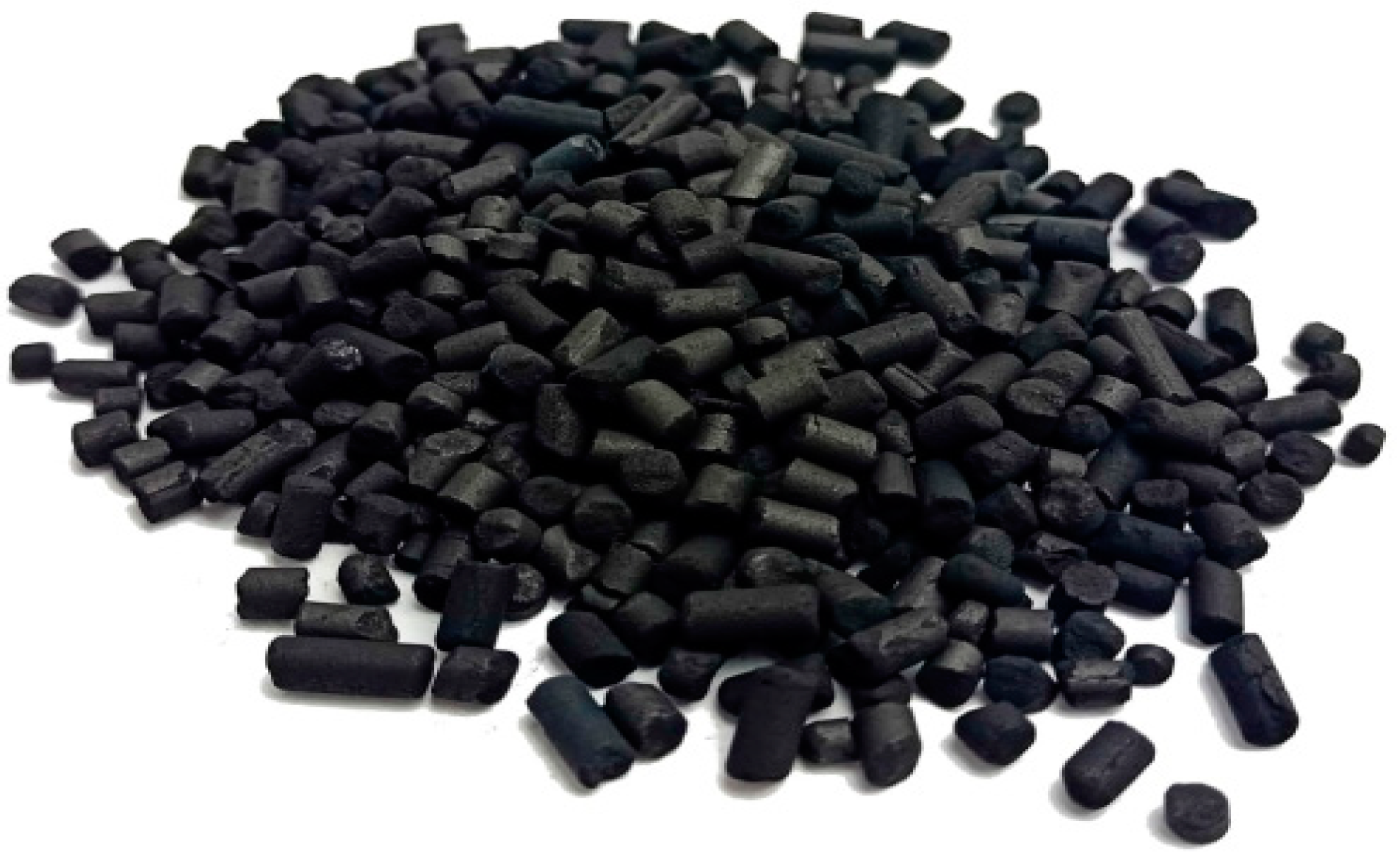

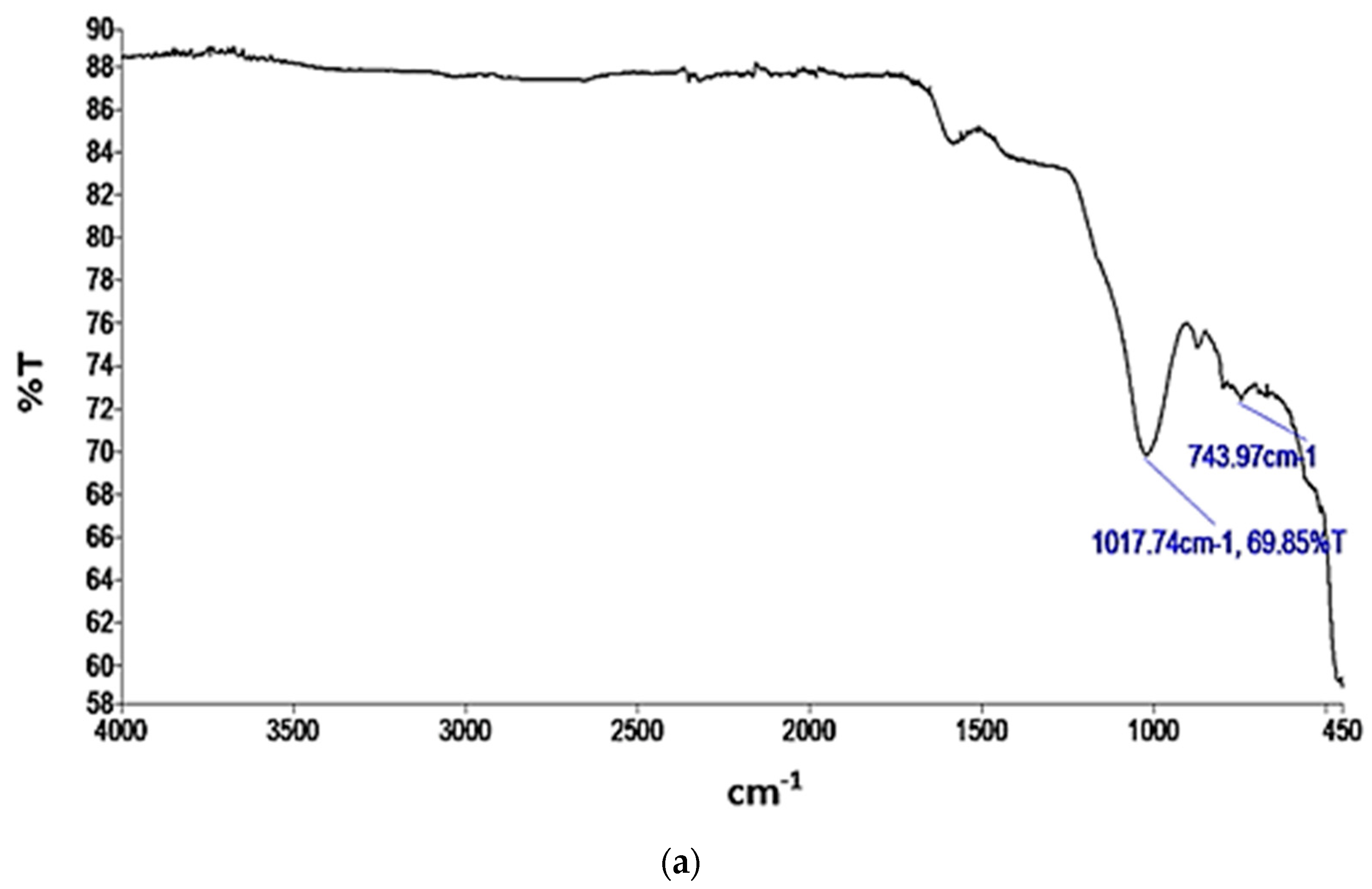
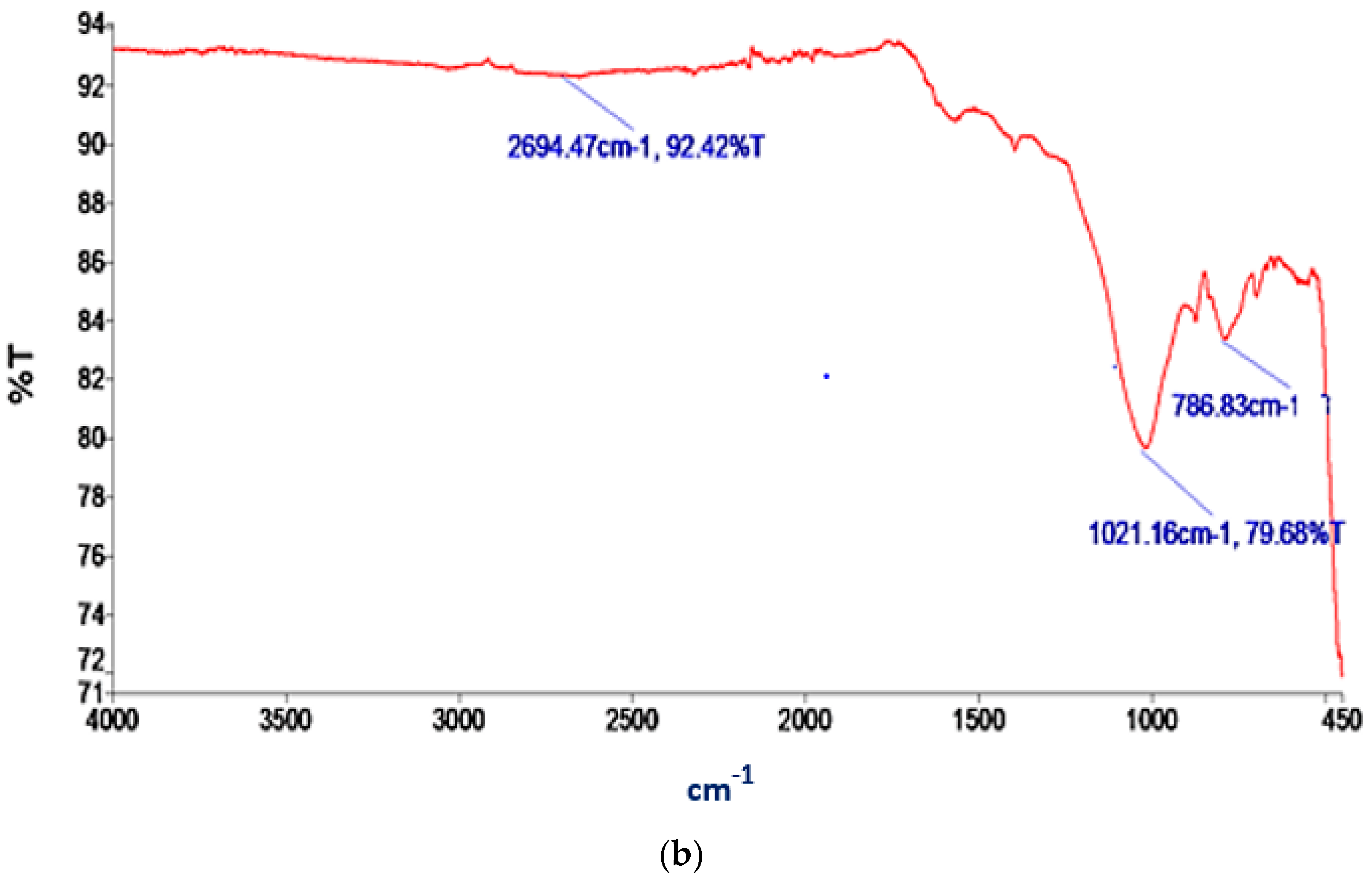
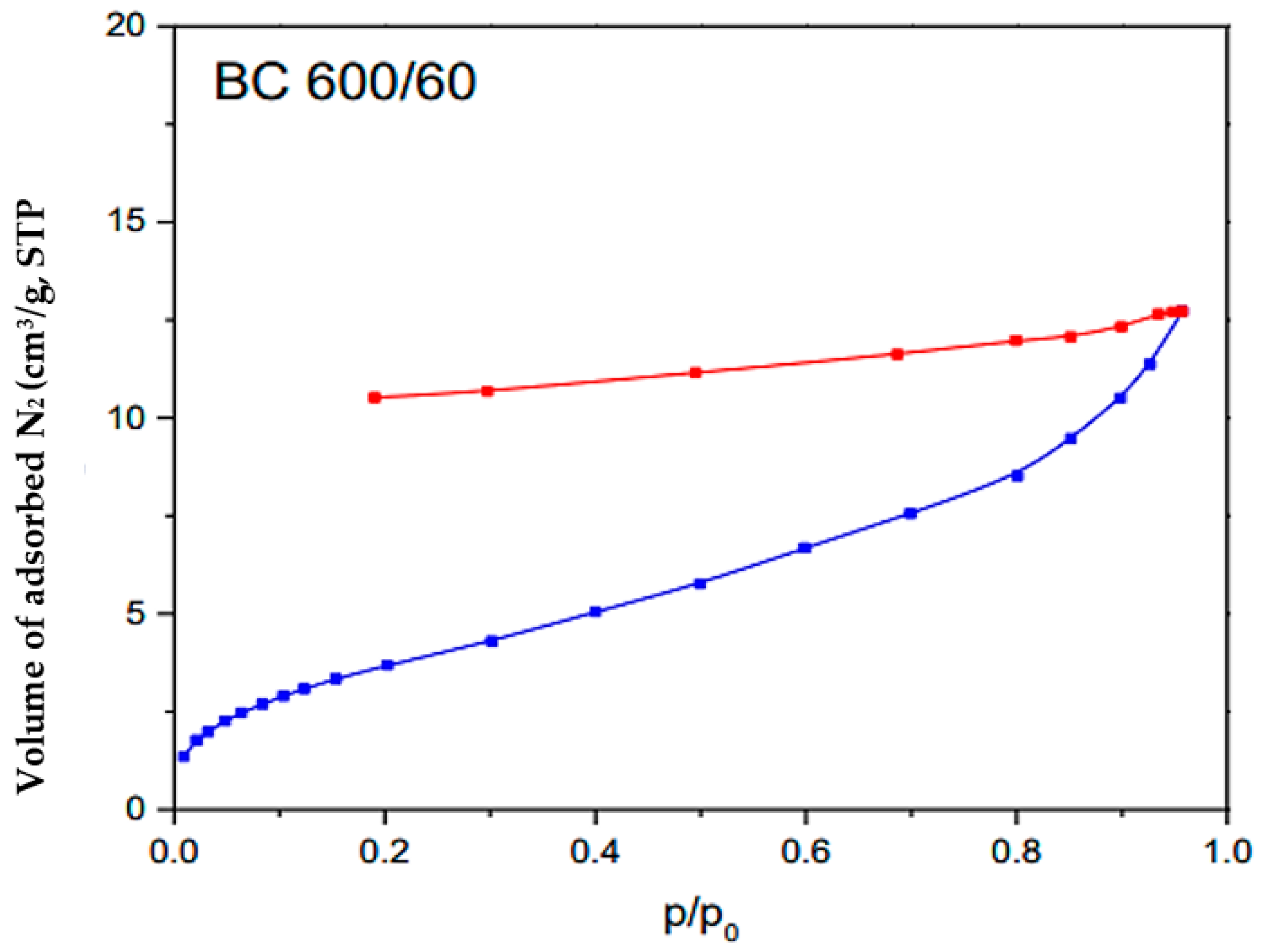
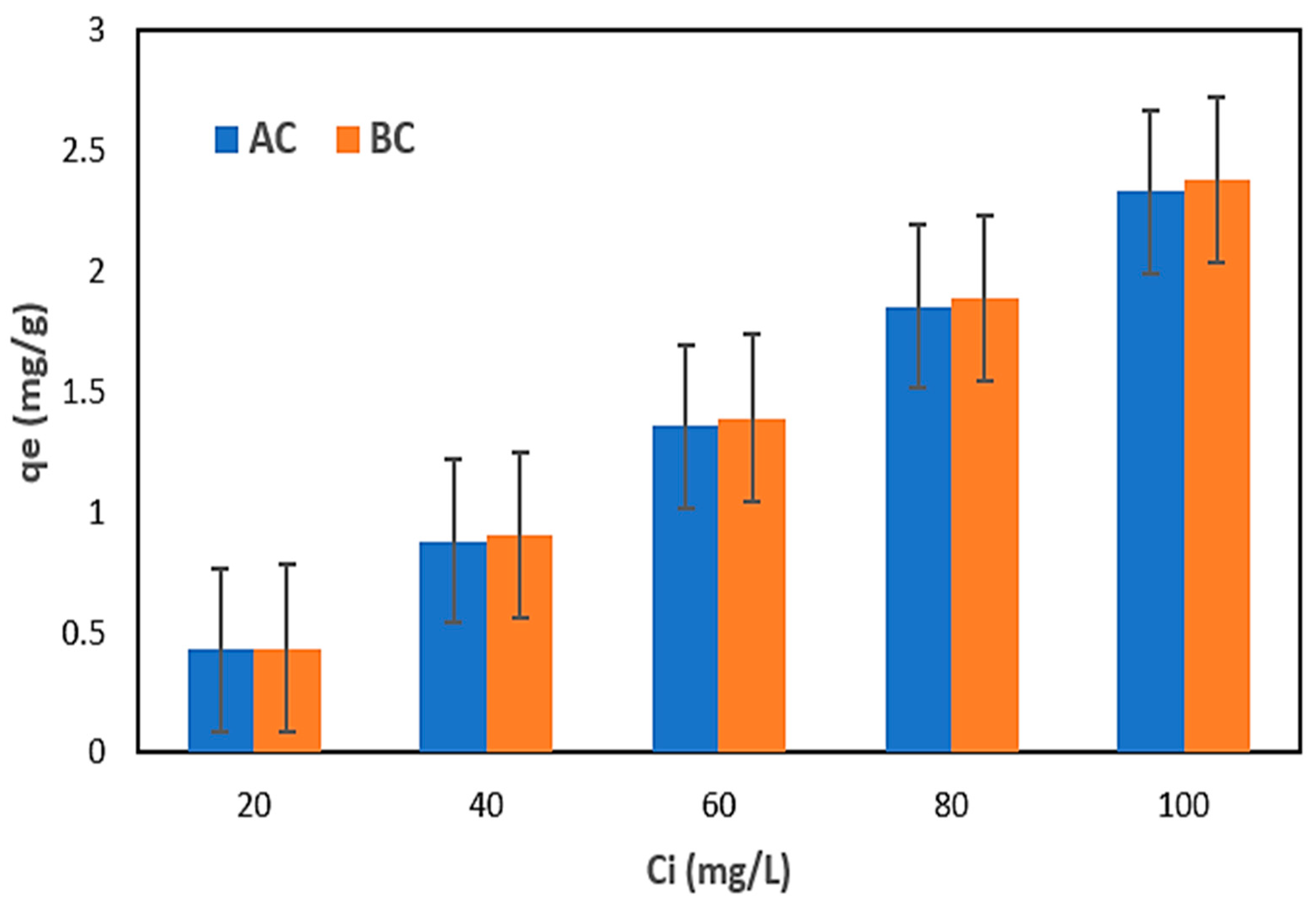
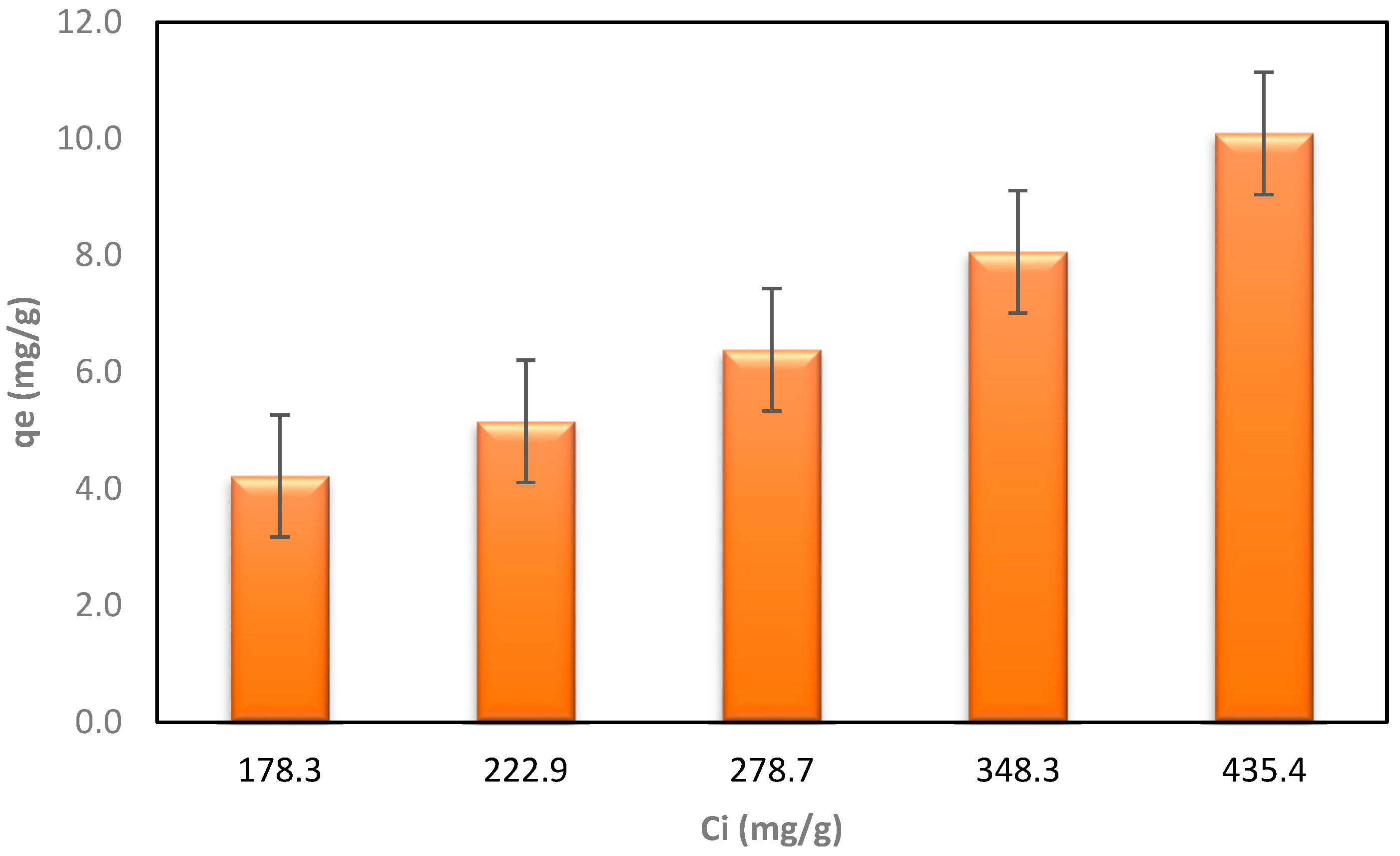
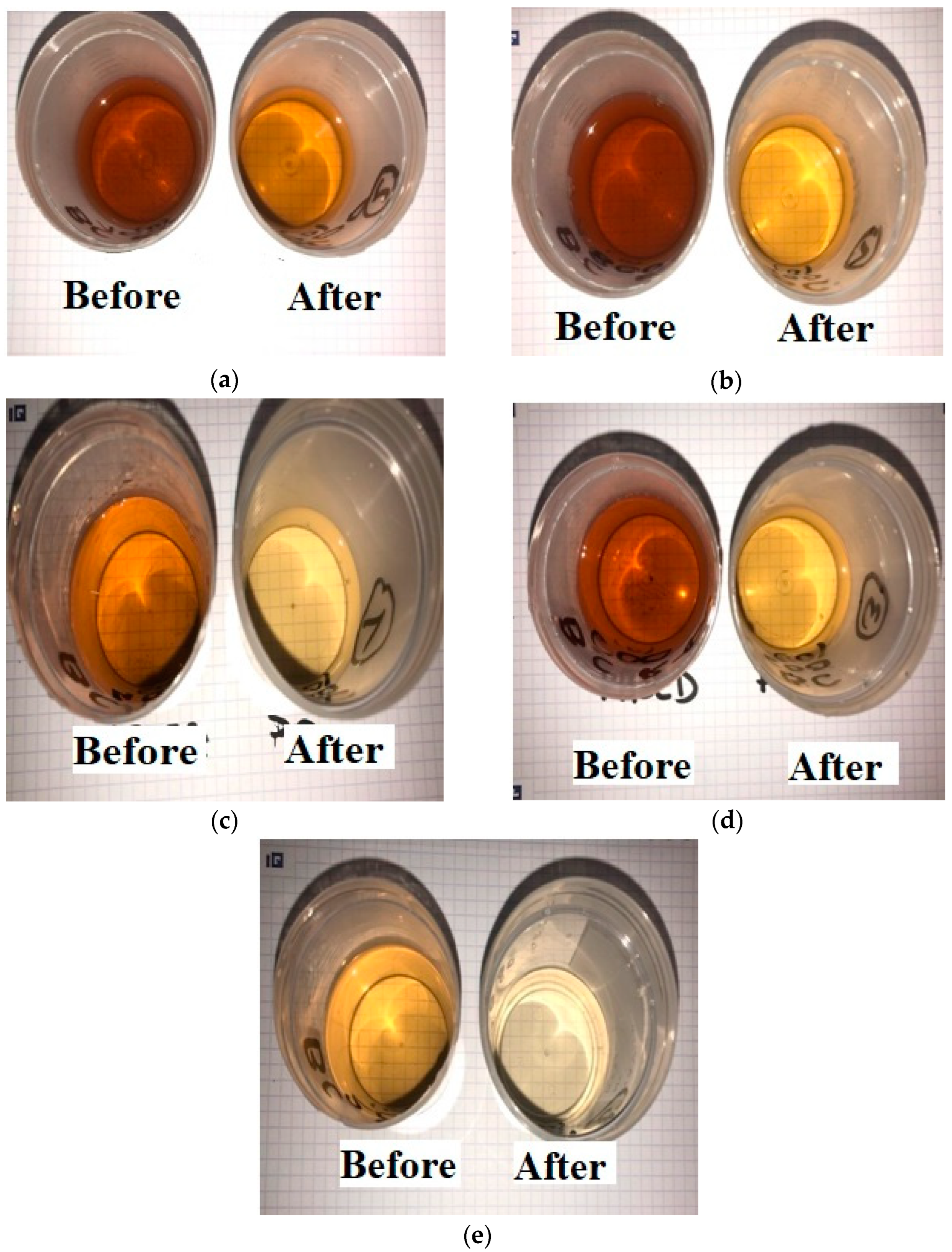
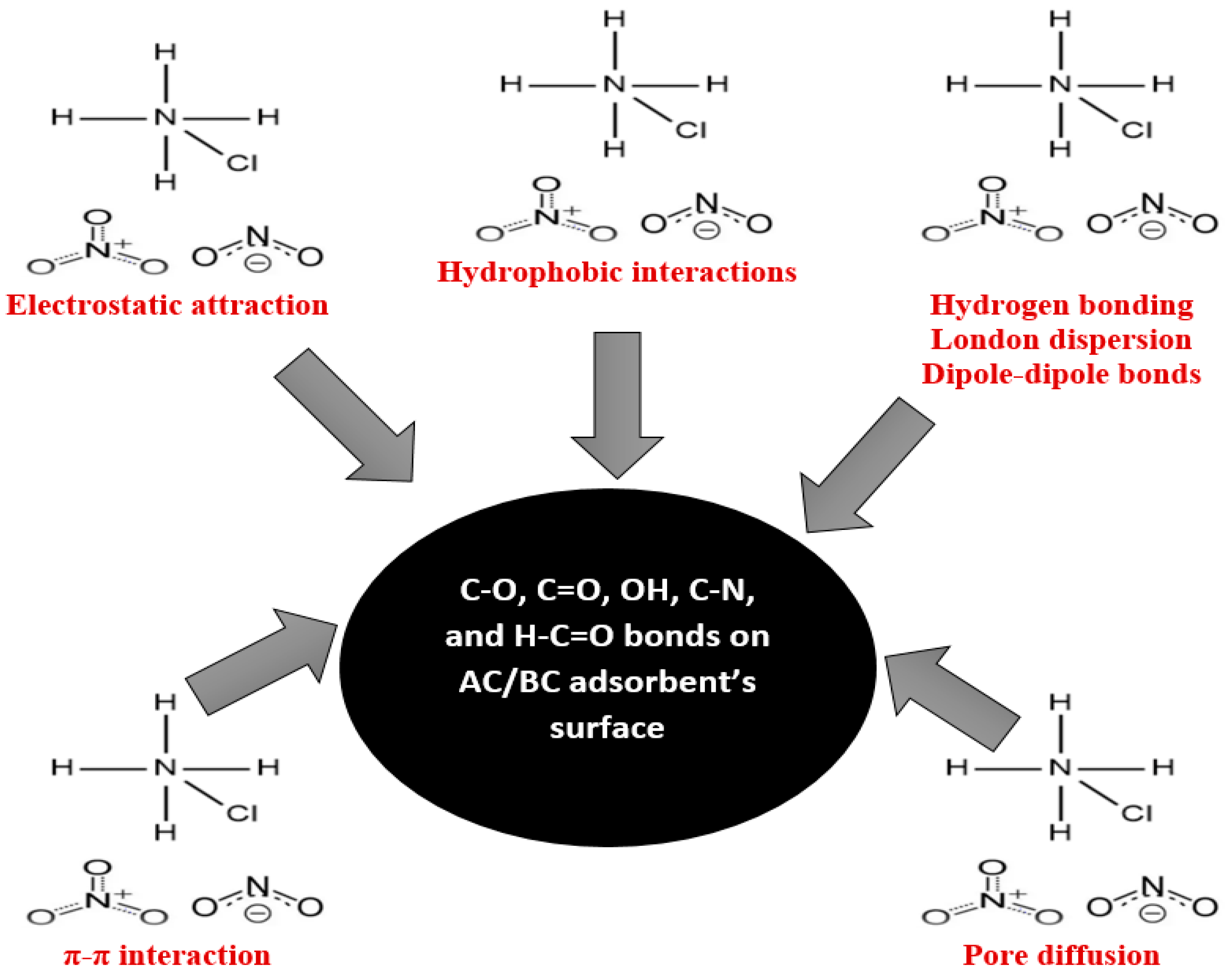
| Parameter | Unit | Analysis Methodology | Result | Measurement Uncertainty |
|---|---|---|---|---|
| Biochemical oxygen demand (BOD5) | mg/L O2 | PN-EN ISO 5815-1:2019-12 [38] | 270 | “±50” |
| Chemical oxygen demand (COD) | mg/L O2 | PN-ISO 15705:2005 pkt 10.2 [39] | 1150 | “±160” |
| General suspensions | mg/L | PN-EN 872:2007/Ap1:2007 [40] | 13 | “±3” |
| Total nitrogen | mg/L | PN-EN 12260:2004 [41] | 430 | “±90” |
| Total phosphorus | mg/L | PN-EN ISO 11885:2009 [42] | 2.8 | “±0.4” |
| General solutes | mg/L | PN-78/C-04541 [43] | 7130 | “±713” |
| Ignition losses | mg/L | PN-78/C-04541 [43] | 5520 | “±552” |
| Ammonium ion/ammonia | mg/L | PN-EN ISO 11732:2007 [44] | >130 | – |
| Nitrates | mg/L | PN-EN ISO 13395:2001 [45] | >445 | – |
| Nitrite | mg/L | PN-EN ISO 13395:2001 [45] | 3.1 | “±0.5” |
| pH | – | PN-EN ISO 10523:2012 [46] | 7.9 | “±0.2” |
| Electrical conductivity (25 °C) | µS/cm | PN-EN 27888:1999 [47] | 10,560 | “±528” |
| Chloride | mg/L | PN-ISO 9297:1994 [48] | 1620 | “±240” |
| Material | %C | %H | %N | %S | %O |
|---|---|---|---|---|---|
| AC | 37.51 | 1.19 | 2.52 | 0.42 | 58.36 |
| BC | 57.74 | 1.85 | 0.51 | 0.46 | 39.44 |
| (Ci), mg/L | (Ce), mg/L | (qe), mg N/g | (R), % |
|---|---|---|---|
| AC sample | |||
| 20 | 2.94 | 0.43 | 85.28 |
| 40 | 4.80 | 0.88 | 88.01 |
| 60 | 6.41 | 1.34 | 90.26 |
| 80 | 5.87 | 1.85 | 92.67 |
| 100 | 6.89 | 2.33 | 93.11 |
| BC sample | |||
| 20 | 2.60 | 0.44 | 87.02 |
| 40 | 4.21 | 0.89 | 90.45 |
| 60 | 4.40 | 1.39 | 92.67 |
| 80 | 3.89 | 1.90 | 94.46 |
| 100 | 4.92 | 2.38 | 95.08 |
| (Ci), mg/L | (Ce), mg/L | (qe), mg/g |
|---|---|---|
| 178.3 | 9.64 | 1.94 |
| 222.9 | 16.71 | 3.94 |
| 278.7 | 23.38 | 5.95 |
| 348.3 | 25.83 | 8.06 |
| 435.4 | 31.63 | 10.09 |
| Isotherm | Parameters | AC/NH4Cl | BC/NH4Cl | BC/LLCH |
|---|---|---|---|---|
| Langmuir | qm (mg/g) | 0.9469 | 0.5738 | 26.667 |
| KL (L/mg) | 0.1044 | 0.1647 | 0.0163 | |
| R2 | 0.9179 | 0.9574 | 0.4013 | |
| Temkin | BT (J/mg) | 40.004 | 51.764 | 30.547 |
| AT | 0.3781 | 0.4192 | 0.1180 | |
| R2 | 0.7044 | 0.6793 | 0.8183 | |
| Freundlich | 1/n | 1.3335 | 2.6116 | 0.7069 |
| KF (L/g) | 0.0102 | 0.0333 | 0.7820 | |
| R2 | 0.9507 | 0.9449 | 0.8977 | |
| Harkins–Jura | A | 0.2575 | 0.2683 | 28.490 |
| B | 3.8835 | 3.7272 | 0.0351 | |
| R2 | 0.8454 | 0.8430 | 0.9992 | |
| Jovanovich | qmax (mg/g) | 0.5730 | 0.5871 | 4.3466 |
| KJ | 0.0317 | 0.0316 | 0.0176 | |
| R2 | 0.8395 | 0.8366 | 0.9744 | |
| Dubinin–Radushkevich | qD mg/g | 2.7977 | 0.3270 | 8.5165 |
| B mol2/kJ2 | 4 × 10−6 | 4 × 10−6 | 1 × 10−5 | |
| E (kJ/mol) | 353.55 | 353.55 | 223.61 | |
| R2 | 0.8768 | 0.8895 | 0.6956 |
Disclaimer/Publisher’s Note: The statements, opinions and data contained in all publications are solely those of the individual author(s) and contributor(s) and not of MDPI and/or the editor(s). MDPI and/or the editor(s) disclaim responsibility for any injury to people or property resulting from any ideas, methods, instructions or products referred to in the content. |
© 2024 by the authors. Licensee MDPI, Basel, Switzerland. This article is an open access article distributed under the terms and conditions of the Creative Commons Attribution (CC BY) license (https://creativecommons.org/licenses/by/4.0/).
Share and Cite
Igwegbe, C.A.; Kozłowski, M.; Wąsowicz, J.; Pęczek, E.; Białowiec, A. Nitrogen Removal from Landfill Leachate Using Biochar Derived from Wheat Straw. Materials 2024, 17, 928. https://doi.org/10.3390/ma17040928
Igwegbe CA, Kozłowski M, Wąsowicz J, Pęczek E, Białowiec A. Nitrogen Removal from Landfill Leachate Using Biochar Derived from Wheat Straw. Materials. 2024; 17(4):928. https://doi.org/10.3390/ma17040928
Chicago/Turabian StyleIgwegbe, Chinenye Adaobi, Michał Kozłowski, Jagoda Wąsowicz, Edyta Pęczek, and Andrzej Białowiec. 2024. "Nitrogen Removal from Landfill Leachate Using Biochar Derived from Wheat Straw" Materials 17, no. 4: 928. https://doi.org/10.3390/ma17040928
APA StyleIgwegbe, C. A., Kozłowski, M., Wąsowicz, J., Pęczek, E., & Białowiec, A. (2024). Nitrogen Removal from Landfill Leachate Using Biochar Derived from Wheat Straw. Materials, 17(4), 928. https://doi.org/10.3390/ma17040928









